| Origin | North America |
| Position | Foreground |
| Height | Varies according to nutrient availability |
| Width | Varies according to nutrient availability |
| Difficulty | Easy |
| Growth Rate | Medium |
| Substrate | Sand, gravel or soil |
| pH | 6 – 7.2 |
| Lighting | Low – High |
| Ideal Temperature | 68-81°F (20-27°C) |
| Carbonate Hardness (KH) | 5-12 dKH |
What do you get if you cross a bunch of bananas with a water lily?
A banana plant!
If you are looking for a unique yet easy-to-grow aquarium plant, the banana plant is exactly what you are looking for. And today, I am going to teach you everything you need to know about them.
Contents
What is a banana plant?
This unusual plant is native to the south and southeast of the United States and is typically found in lakes, ponds swamps and slow rivers. In Maryland, the banana plant is such a rare sighting in its natural habitat that it is classified as endangered.[1][2]
While the banana plant may be a threatened plant in its natural environment, you won’t have any difficulty tracking down a seller, should you want a banana plant in your aquarium. Don’t worry! Banana plants are grown from cuttings of established banana plants and are not collected from their native habitat.
What are other names for banana plants?
- Aquatic banana plant
- Underwater banana plant
- Banana lily
- Heart water lily
- Big floating heart
- The brain plant
But among the aquarium community, this plant is usually referred to as the aquarium banana plant or by its scientific name Nymphoides aquatica.
How do you identify an aquarium banana plant?
You will instantly be able to identify a banana plant by its tubers – they resemble an unripened bunch of bananas…
These thick tubers are the part of the plant where the nutrients are stored. Many beginners confuse the tubers for the roots of the plant. However, this is not the case, and if you plant the tubers under your substrate, they will soon rot.
The roots of the aquarium banana plant actually grow from the stem of the plant. And as you would expect, they look more… rooty. The thin roots grow downward, toward the substrate and are either white or light green in color.
Now, the leaves are where things get interesting. While it will produce multiple leaves that stay underwater, the banana plant will shoot a runner toward the surface of your aquarium. Within a week or so, you will have a lily pad sitting at the top of your aquarium.
That’s a long stem, right? I have seen these stems grow as long as 28 inches!
Although they are typically light to dark green, it’s not uncommon for the leaves of a banana plant to have a patchy red color.
How do you plant an aquarium banana plant?
Want to know something cool about the banana plant? It can either be left to float or you can plant it in the substrate of your aquarium.
A healthy floating banana plant takes more effort than one planted in the substrate, and liquid fertilizer is a must.
Curiously, a floating banana plant will eventually produce roots that will grow down into your substrate, anchoring it into place. I have seen these roots grow as long as a foot!
Below, you see an example of a floating banana plant with its roots seeking out the substrate underneath.
For beginners, and those of you just looking for an easy-to-grow plant, I recommend planting the banana plant in the substrate of your aquarium.
If you are planting in soil, no fertilizer is required because the soil will provide all the nutrients your banana plant needs to grow big and healthy.
Sand and gravel, on the other hand, do not provide the same nutrients. If you want to plant your banana plant in either of these substrates, then I recommend using root tabs. Simply push a root tab into the substrate near the root of your plants, and it will release all the nutrients your banana plant needs to grow!
Be mindful, however, that no more than 1/3 of the banana-like tubers should be buried in your substrate. Any more than that and the tubers may begin to rot.
Don’t want your banana plant to float? Keep it in place by using a plant weight, glue or even tying the banana plant to a rock.
Once the banana plant’s roots are established, they will be able to hold the plant down. At this stage, your weight or tethers can be removed.
Note that in some instances, the roots have been known to lift the banana plant up, making the plant look like it’s floating in mid-air. Well, mid-water, anyway!
As for lighting, banana plants grow well under both low or high light. However, if you want to see the banana plant grow its heart-shaped lily leaves on the surface, then medium to high light is best – in low light, the leaves are likely to stay submerged.
In fact, in an aquarium setting, many hobbyists choose to stunt the growth of the plant. The reason? The leaves that surface might look pretty, but they can pose a problem to the other plants in your aquarium by blocking out the light.
By lowering the light and temperature and skipping the CO2, you can simulate winter conditions. The result is smaller leaves and shorter stalks, meaning you don’t have to worry about the banana plant taking over your tank.
Alternatively, a quick snip with a pair of scissors and the lily and stem are removed from your banana plant.
Lighting can also affect the color of your banana plant. In low lighting conditions, the banana plant will have a dark green coloration while medium to high light will see it turn a light-green color.
As for temperature, let’s just say there is a reason that the banana plant prefers to grow in the southern states of the US – the climate.
Banana plants prefer warmer temperatures, making it a great addition to your tropical tank. Even so, the banana plant will tolerate temperatures as low as 50°F (10°C). However, its growth will be stunted.
Finally, there’s water movement. Banana plants typically grow in slow-moving rivers, creeks and ponds. As you might have guessed, this means that they don’t like fast water movement where the current will blow the lily pads around your tank. So, reduce the flow rate of your filter, if necessary.
Propagating your banana plant
Why buy more banana plants when you can grow them yourself?
Once your banana plant has shot a runner to the surface, wait for the lily pad leaf to unfurl. Once mature, cut the stalk off so that at least 4 inches (10cm) remains.
Place the cutting back inside your aquarium and wait a few weeks. Before long, you will notice small white roots beginning to form at the base of the stalk like this…
You might even notice the beginnings of new leaves starting to grow. Now, all that is left to do is to plant the roots in your substrate.
For the best chance of success, your tank needs to meet the recommended growing conditions – low water flow, dosing liquid fertilizer and medium to high lighting.
Troubleshooting banana plants
Snails and plecos are both known to chomp on banana plants. If you come home to discover your banana plant has been devoured, there is a good chance that one of these two are to blame.
Another problem is the banana plant losing its tubers…
There are two theories behind this.
The first is excess nutrients. The banana-like tubers are where the plant stores its nutrients. If the roots are pulling enough nutrients out of your substrate and water, then there is no need for the tubers, and they fall off.
The other is that the plant isn’t actually a Nymphoides aquatica but instead a plant that looks incredibly similar, Nymphoides mexicana, which sheds its tubers.
In either case, the tubers falling off does not mean that your plant is unhealthy or dying. If the leaves, stalks and rhizome all look normal, and growth is consistent, then there is no need to act.
Conclusion
If you are looking for a plant that is easy to take care of, look no further than the banana plant. The best part is that once you have one, you can easily grow more!
Do you have banana plants in your aquarium? Let me know in the comments below!

Ian Sterling, founder of Fishlab.com, began his aquarium journey over 30 years ago, driven by a deep fascination for fish and their diverse personalities. His website, Fishlab.com, is dedicated to making fishkeeping accessible and enjoyable, offering beginner-friendly guidance, expert insights, and a community for aquarists to connect and share experiences.


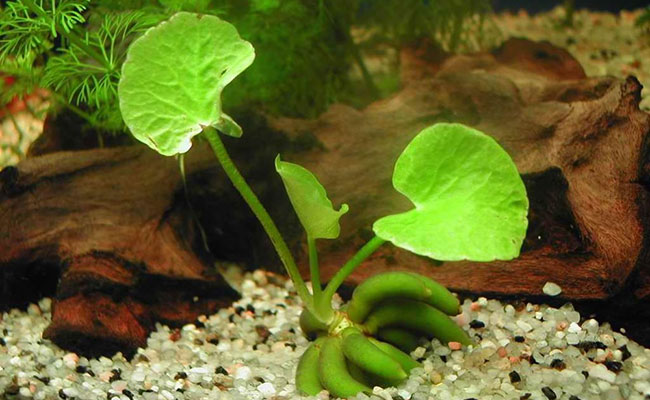
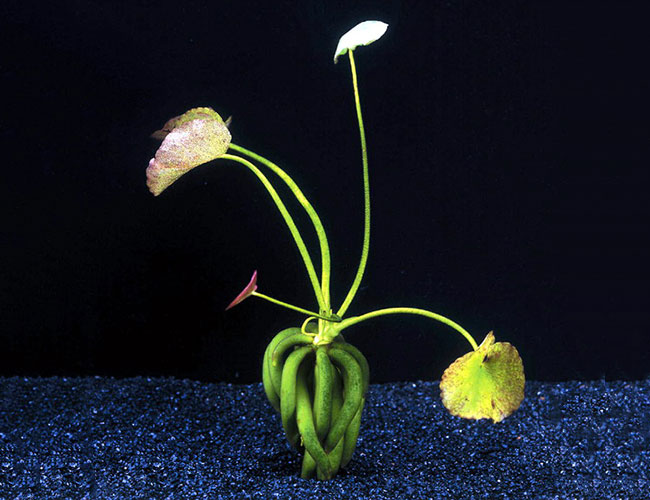
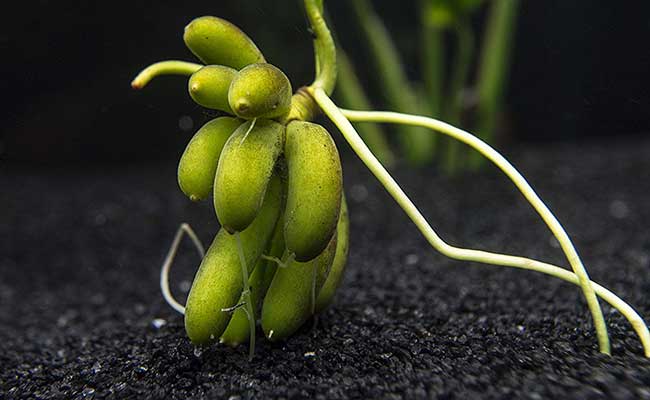
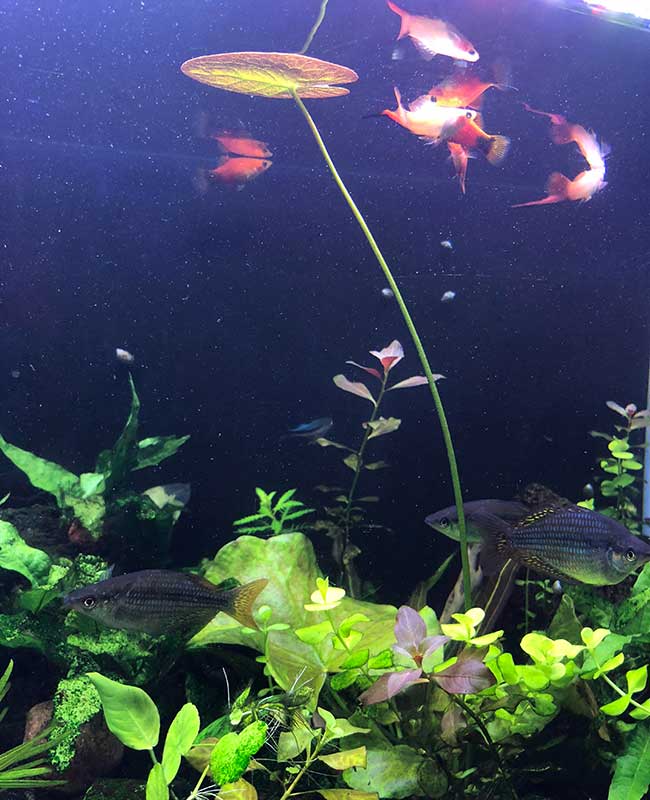

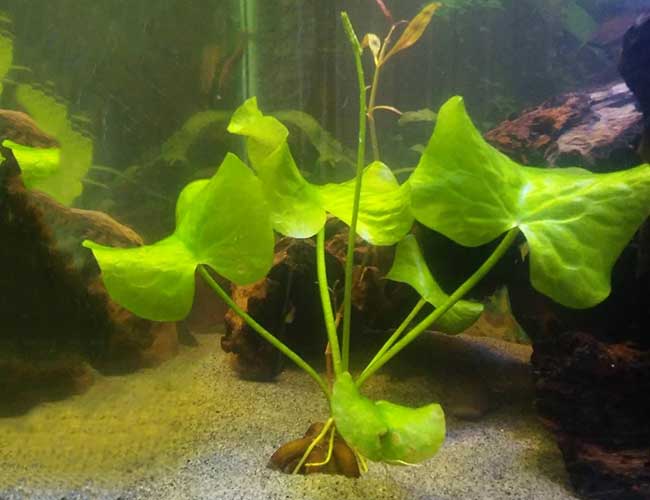
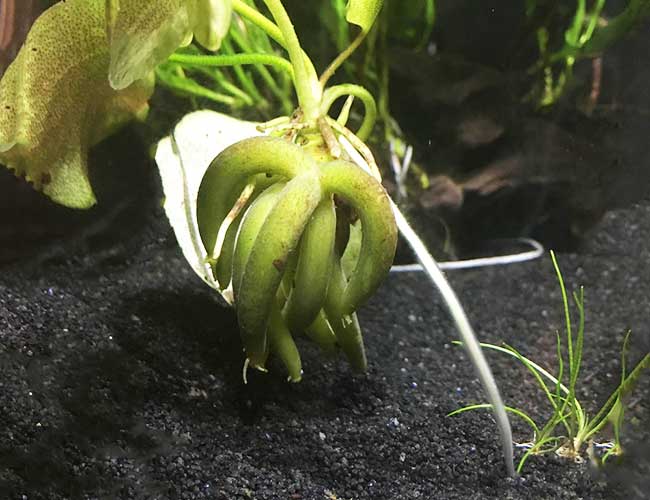
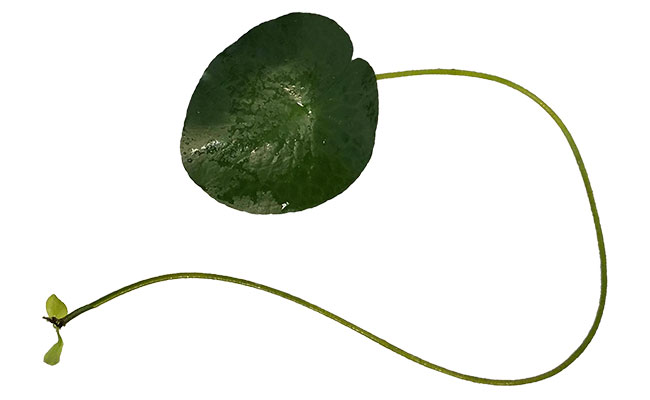
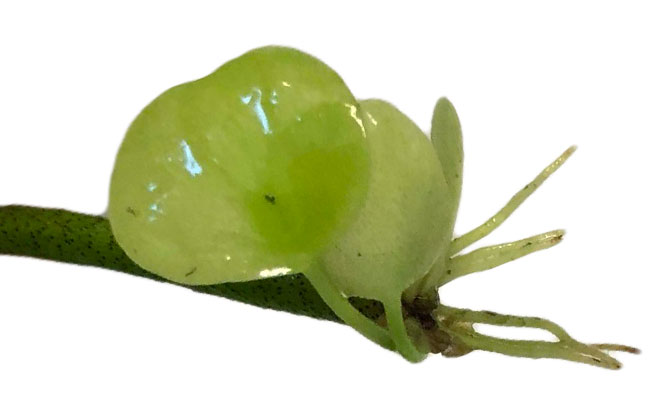
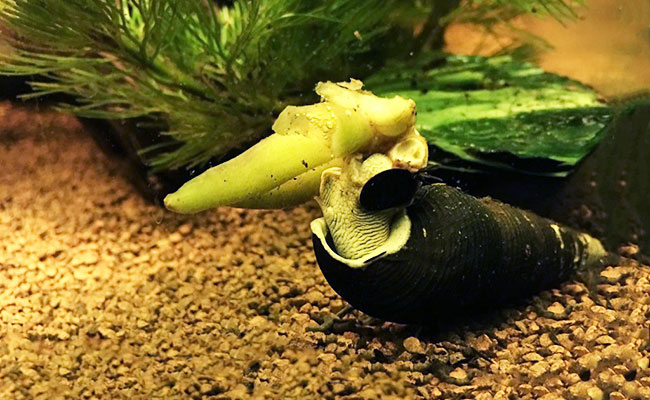
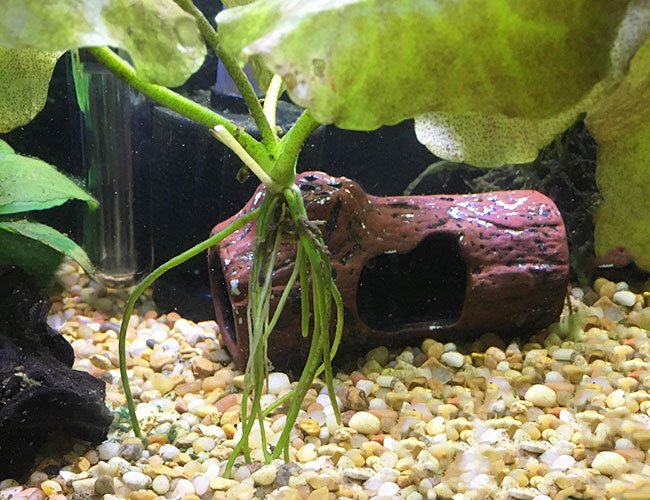
Comments (42)
No need to publish my comment, but thanks a lot for this awesome article! Very descriptive. Appreciated.
Hi Gabriel,
Thanks for the lovely feedback – it inspires me to make more detailed guides on aquarium plants in the future.
Mr. Sterling, thanks for the article. One question. Can you speak to the amount of phosphate or manganese that these plants need for good growth?
Hi Tim,
Not with confidence. Anecdotally, my niece has a banana plant in her tank, and her phosphates are around 3 ppm. While it’s a relatively new addition, it’s already shooting a runner to the surface.
I recently bought a banana plant and I love it! The only thing was that I wished that the tubers were shorter. Is there anyway I can cut or trim the tubers without harming the plant? Thank you very much.
Hi Carter,
Excellent question!
You actually have me stumped. I have never had experience with this and I have never seen someone attempt it. I don’t think my niece would appreciate it if I experimented on hers banana plant either.
If you were to cut all of them I believe that it would lead to the death of the plant. I’m happy for anyone else with experience reading this to jump in and say otherwise!
Could you bury them 1/3 into your substrate instead? It will give the appearance of shorter tubers.
My plant looked beautiful for months now the little banana parts have turned black. What did I do. Or what can I do.thanks
Hi Ginny,
Some tubers do darken in color, it’s normal. If they are darkening to the point of rotting, there may be something else at play. Have you checked your water parameters and made sure they fall in line with your banana plants preferred water?
In my experience these are highly seasonal plants – maybe its according to the temperature but mine always blew up in the summer then hibernate for the winter. Of course they sell these in pet shops and tanks are always indoors so always try to simulate the seasons a little bit helps. I remember when I first purchased one I put it in a flourishing and meticulous planted tank and everything but it was growing out of control until 8 months later when spring started warming up and it just blew up with 5-6 runners coming to the top- which then fell off again when it got cold again.
Hi Andrew,
That’s very interesting, I have never kept these in a tank where water temperature has not been constant. Of course it makes sense in a natural environment a plant would go through a cycle of growth according to season. With that said, I have also never had a problem where growth has been worryingly stunted. The ability to vary the season would entirely depend on the water temperature preference of the fish you also keep in a tank. It would make for a fun experiment in a purely planted tank though.
Very clear language, great pictures and right to point. Can you do more plant guides?
Hi Lou,
Glad I could help. I do have plans for more plant guides in the future, do you have any suggestions?
The lily pad leaves seem to be dying but the tubers keep sending up new ones, should I cut off the dead ones?
Hi Joan,
If it was me, I’d be cutting off the dead ones.
Can anyone answer this, if you cut the lily pad off to grow another plant will that stem sprout a new leaf. I recently purchased 2 bannanna plants, one had 1 lily pad and three stems that were obviously cut to produce new ones before being sent. Do i leave the bare stems be because they will grow new leaves or trim them off at the ryhzomes because they are now just stems?
Hi Firemonkey,
I’d just cut the stems back, or leave them. It makes no difference. Based on my experience, mine have never re-grown the leaf once it gets cut.
I am confused with the planting
Do you just drop it on top of the substrate (I have seachem fluorite gravel for planted tanks),or do I partially bury the banana tubers?
Hi Bill,
If you are dosing with fertilizer you can float it. If you are relying on the substrate for nutrients, bury the tubers so that no more than 1/3 are covered.
I bought 3 banana plants 9 days ago. 2 in one tank and 1 in another. It had no white roots and 2 leaves. It now had white roots that are 4 inches long and has 5 leaves. Is this normal? Im new to aquariums and live plants. I think i like my plants more than the fish lol.
Thank you for the article, very informative.
Hi Teri,
If your banana plant shows no signs of rotting and or color loss then this sounds perfectly normal. I share your love of aquarium plants, they are like a magical underwater garden!
My banana plants main part is turning brown is that okay? Or should I be worried? Also can you post a picture of a rotting one?
Hi Ashley, unfortunately, I don’t have any photos of a rotting banana plant to show you 🙁 Are the tubers turning brown or are they being covered with a dark colored algae (if you rub it, does it come off?) I have seen some cases where the tubers have darkened in color, but not to the point of turning brown.
Ian Sterling I was looking at information on the banana plant because of the fact that I’ve been working on setting up a hilstream Aquarium&of course what stream doesn’t have water lilly’s however most get to big for use in 20-30gallon Aquariums;it seems as if the bannana plant might just be the answer!
Hi James,
Hillstream loaches are beautiful fish! Great idea on adding an aquarium banana plant to imitate a water lilly.
a banana plant i had grew a big leaf to the top and them the leaf died. now she only haves 1 leaf and 1 more growing(she has roots and all tubers healthy, one of the tubers dark brown)
i am treating the aquarium because fish got sick with ich(the aquarium is 30 degrees celsius now), do you think when i lower the temperature the banana will grow again?
and answer me a question please, when cutting the stalker for a new plant, i must bury the end of the stalker?
Hi Gabriel,
The banana plant should continue to grow once you lower the temperature, assuming it’s alive.
As per the guide above, they can be free-floating or your can bury them.
Yesterday was algae scraping Day and I decided to check the banana. All the tubers where rotten, and now there is only this:
https://1drv.ms/f/s!AqGI6w4-Z0Y1ygbKeLabgzSo-GMr
Very good info. Im adding some to my shrimp tank. The big test for them. Shrimp love plants so will be interesting to see. I will try and keep posted. Over 500 shrimp in this tank. Have a good day and thank you.
Hi Doug,
I don’t think you’ll have any issues with shrimp eating them. I’ll be curious to see how the interact with the banana plant. Please keep me updated! Thanks for sharing.
I have only just found these amazing little bundles of delight, rather funny as it grows in the south were I’ve lived my entire life. I have two Cichlid tanks a 55gal and a 30gal. I only purchased one for my 55 and my wife insisted on having a couple for each tank. Since I know better than to argue with her because she is usually right I am delighted to say they are my new favorite aquatic plant. we now have 5 in each tank and thanks to your article we now can spread the joy to friends and family who are also aquariumest. Thanks so much for sharing your knowledge with us and we will be looking forward to more articles.
Hi Drenen,
Thanks for the kind words. I agree, they are an amazing plant, completely unlike any other. I’m glad to hear they have improved the look of your Cichlid tanks!
Hi Ian, I have just received some banana lily seeds, not sure what to do with them or even if they are genuine. I ordered what I thought was a plant.
Do you know if seeds are viable and if so how to deal with them? TIA
Cath Harrison
Hi Cath,
You actually have me stumped, I have no experience growing a banana plant from seed. I have only ever either transplanted or used a runner.
Is This plant compatible with Beta Fish?
Hi Cindy,
Yes, the banana plant is compatibale with betta.
My plants have been growing for about 2 months,but in the last 2 weeks they have gone crazy. The leaves are 3-4 inches across and have pinkish stripes in them. We watched the one grow 20 inches to the top of the tank in 4 days. They are beautiful. The floating lily pad is purple!
Hi Ed,
Thanks so much for sharing your experience. I love banana plants for the very reasons you have listed, it’s really fun watching them grow and change over time – it sounds like you are taking great care of them!
I am also growing red Ludwigia in the same tank. It grows like mad but the bottom 3/4 gets algae covered. Using led lights. Any ideas?
Ed
Hi Ed,
Once again likely a nutrient balance issue.
Hello, I have had banana plants before in other tanks and have recently gotten a new tank and was able to get another banana plant. The issue I had with my plants before was with algae growing on the tubers. Can you tell me what I can do to keep this from occurring and should it happen how to combat it? Also my local fish store (not big box) chose the plant and this is the one I was given. Any suggestions…
https://silentvice68.tumblr.com/post/190668669324
Hi Tina,
Any unwanted algae growth is typically a nutrient issue. Balancing nutrients in a planted tank is very much trial and error according to what you stock – but it’s also arguably part of the fun of figuring out your unique tank.
From what I can see in the image, that looks like an otherwise healthy Banana plant. It will no doubt change over the coming weeks/months as it adapts to the water in your tank, but I don’t see anything wrong with it?
If you are willing to have a new pet in the tank, shrimp work wonders on cleaning plants. Cherry shrimp, ghost shrimp and many others will work great.